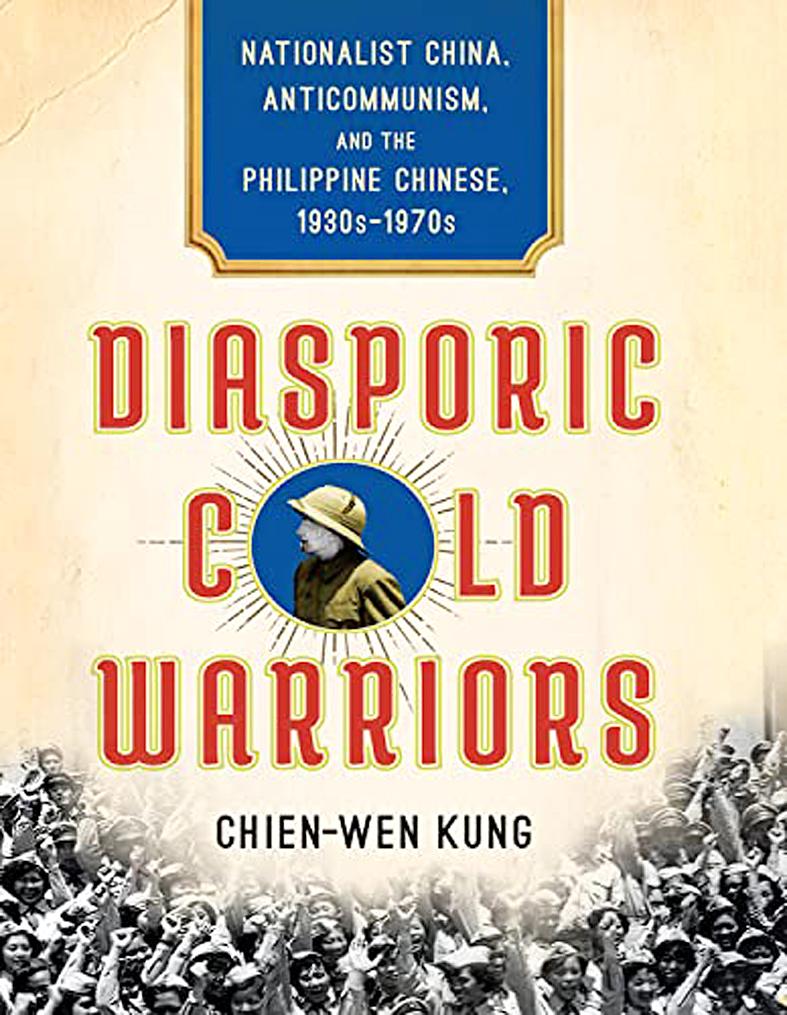In 1950, the overseas Chinese community of the Philippines numbered 230,000 — just over 1 percent of the country’s population. This made it among the smallest overseas Chinese communities in Southeast Asia. In comparison, Thailand had more than 3 million Chinese residents that same year.
Yet, throughout the decade and well into the next one, donations from Philippine Chinese — the preferred term in this book — to Chinese Nationalist Party (KMT) coffers dwarfed those from other Southeast Asian nations. In several years, they amounted to more than the “patriotic voluntary contributions” from Thailand, Indonesia, Malaya and South Vietnam combined.
More importantly, for the KMT, this fealty manifested itself through the creation of what Kung Chien-wen (龔建文) calls an “intra-Asian anti-communist ecumene” in which the Philippine Chinese Cold Warriors of the book’s title represented the vanguard.

“For two decades from the KMT’s flight to Taiwan in 1949 to the early 1970s, no overseas Chinese community was as active in identifying and rooting out suspected Reds from its midst,” writes Kung in the book’s introduction.
There were many factors behind Philippine Chinese support of the KMT. Around 85 percent of Philippine Chinese at that time were Hoklo, with 90 percent of that figure originating from the same three counties in what was then Quanzhou prefecture (泉州), the community was anomalously homogenous. This, Kung asserts, “largely inhibited feuding” of the type seen among Chinese in other countries, which in turn may have made Philippine Chinese more malleable.
(An interesting aside that is perhaps beyond the author’s remit, and thus not remarked upon, is the fact that the KMT’s inculcation of overseas support from a predominantly Hokkien-speaking population in the Philippines was contemporaneous with the drive to all but extirpate the language in Taiwan.)
Another reason was the KMT’s link to Chinese Philippine anti-Japanese groups, the largest and most influential of which found in communism a new target for its rabid patriotism. As Kung reveals in chapter six, the Chinese Overseas Wartime Hsuehkan Militia (COWHM華僑戰時血幹團), which fought alongside US forces during the Battle of Manila, visited Taipei more than any other Chinese Philippine “civic” group. These tours included grand ceremonies at which plaques and funds were presented to Chiang Kai-shek (蔣介石) and morale boosting side-trips to the front lines at Kinmen.
For some diehards, anticommunism was a lifelong creed, the pursuit of which was never abandoned. In his conclusion, Kung mentions an interview with Lim Soo Chan (林樹燦) who aged 95 insisted anticommunism was something “we could not give up.”
TARRED WITH A RED BRUSH
For others, it was a matter of expedience and “fashioning the right civic identities” in a society where they were viewed with suspicion. This required “a diverse repertoire of tactics that Chinese from different social classes employed to consolidate their reputations, forge useful elites and attack or defend themselves against each other.”
Post-World War II, attempts to tar others with a red brush replaced accusations of collaboration with the Japanese as the favored mode of extortion. Among the blackmailers, a former secretary general of the KMT in the Philippines, Shih I-sheng (施逸生), emerges as the most flagrant. By conservative estimates, he had made at least half a million pesos (over US$102,000 at current prices) by threatening his fellow prominent overseas Chinese.
Whatever the motives, the rise of the Cold Warriors was enabled by the KMT’s deep penetration into the overseas Chinese community. The leeway, which the Republic of China (ROC) authorities in Taipei were granted to interfere in the Philippines was remarkable. They were unable to replicate this arrangement elsewhere in Southeast Asia, where governments were often almost as wary of Chiang’s agents as potential communist subversion.
TRANSNATIONAL ROOTS
In Malaya, for example, the British colonial authority banned the KMT for a third and final time in 1949. Concerns over the organization’s criminal connections were cited, but — as Kung points out — the KMT’s increasing share of foreign exchange was probably just as important. A year earlier, Thai Prime Minister Field Marshal Plaek Phibunsongkhram had also declared the KMT illegal, reneging on a 1946 treaty of amity.
Also in 1946, the fledgling Indonesian republic, which was still embroiled in conflict and negotiation with its Dutch former rulers, bestowed citizenship on all Chinese who had been born in the country and lived there for five straight years to “minimize the number of Chinese over whom the ROC could exercise jurisdiction.”
The situation in the Philippines was very different. Borrowing from former diplomat and academic Stephen Krasner and historian Nicole Phelps respectively, Kung describes the hand in glove cooperation with various Filipino regimes as a kind of “shared sovereignty” or “body-based sovereignty.”
The wider implication of this is a depiction of the KMT as a transnational power. Indeed, as Kung points out, this was very much in keeping with the party’s origins in revolutionary movements founded and funded by overseas Chinese. These roots were played up, giving the party faithful a sense of being part of a continuum, something greater than the sum of its parts.
Not everyone was on board. Yet, after two high-profile crackdowns in the 1950s, there was almost no serious communist presence left by the end of the decade. Instead, dissent, such as it was, came from elements that Kung calls anti-anticommunists or non-anticommunists. Foremost among these were the Yuyitung brothers — Rizal (于長庚) and Quintin (于長城) who ran Chinese Commercial News (華僑商報), one of the biggest Chinese-language publications in the Philippines.
DISMANTLED AND DIVESTED
Progressives who were committed to the full integration of the Chinese community into Filipino society, the Yuyitungs maintained balance in their reporting on China and Taiwan. Their use of verbatim translated reports from international news services and refusal to employ the prescribed KMT vernacular (“communist bandits,” etc) led to them being branded communists.
It is ironic that Marcos cooperated with the KMT on arresting the brothers then deporting them to Taiwan in 1970, perhaps as a trial run for the martial law he enforced two years later. For, in subsequently implementing the Filipinization of the overseas Chinese that the Yuyitungs had championed, Marcos simultaneously dismantled the separate Chinese education system that was inculcating a new generation of Cold Warriors and divested the KMT of its power base.
This, and many other peculiarities from this little-known historical period and locale are explored and analyzed with aplomb in this fascinating and important work — a must for anyone interested in the Cold War Sinosphere.

June 9 to June 15 A photo of two men riding trendy high-wheel Penny-Farthing bicycles past a Qing Dynasty gate aptly captures the essence of Taipei in 1897 — a newly colonized city on the cusp of great change. The Japanese began making significant modifications to the cityscape in 1899, tearing down Qing-era structures, widening boulevards and installing Western-style infrastructure and buildings. The photographer, Minosuke Imamura, only spent a year in Taiwan as a cartographer for the governor-general’s office, but he left behind a treasure trove of 130 images showing life at the onset of Japanese rule, spanning July 1897 to

One of the most important gripes that Taiwanese have about the Democratic Progressive Party (DPP) is that it has failed to deliver concretely on higher wages, housing prices and other bread-and-butter issues. The parallel complaint is that the DPP cares only about glamor issues, such as removing markers of Chinese Nationalist Party (KMT) colonialism by renaming them, or what the KMT codes as “de-Sinification.” Once again, as a critical election looms, the DPP is presenting evidence for that charge. The KMT was quick to jump on the recent proposal of the Ministry of the Interior (MOI) to rename roads that symbolize

On the evening of June 1, Control Yuan Secretary-General Lee Chun-yi (李俊俋) apologized and resigned in disgrace. His crime was instructing his driver to use a Control Yuan vehicle to transport his dog to a pet grooming salon. The Control Yuan is the government branch that investigates, audits and impeaches government officials for, among other things, misuse of government funds, so his misuse of a government vehicle was highly inappropriate. If this story were told to anyone living in the golden era of swaggering gangsters, flashy nouveau riche businessmen, and corrupt “black gold” politics of the 1980s and 1990s, they would have laughed.

Imagine being able to visit a museum and examine up close thousand-year-old pottery, revel alone in jewelry from centuries past, or peer inside a Versace bag. Now London’s V&A has launched a revolutionary new exhibition space, where visitors can choose from some 250,000 objects, order something they want to spend time looking at and have it delivered to a room for a private viewing. Most museums have thousands of precious and historic items hidden away in their stores, which the public never gets to see or enjoy. But the V&A Storehouse, which opened on May 31 in a converted warehouse, has come up